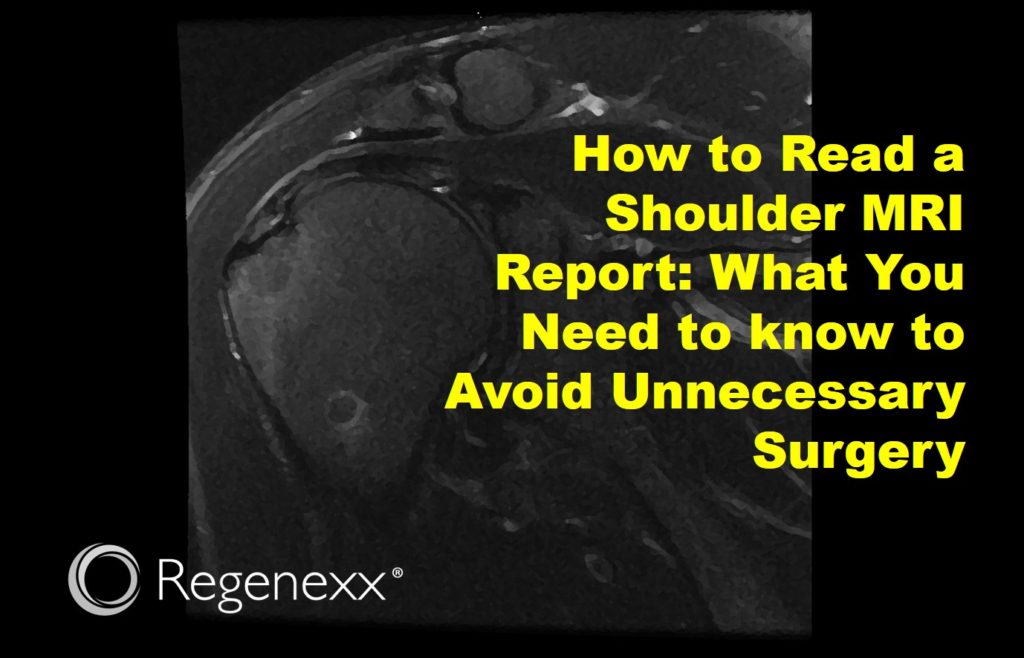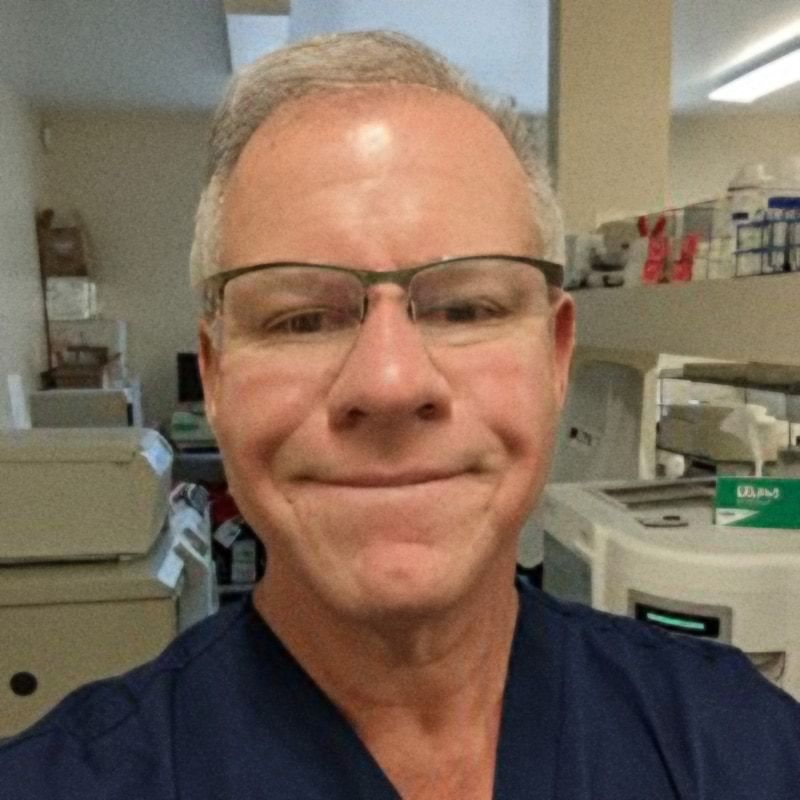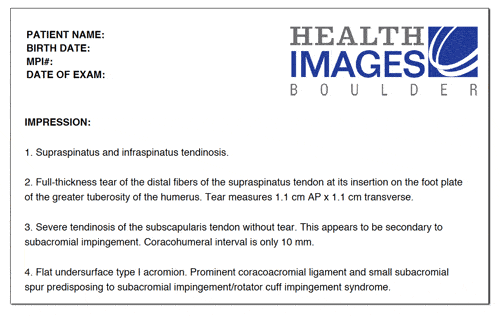What’s a Normal vs. Abnormal Shoulder MRI?
On this page:
Patients often get a shiny new shoulder MRI CD and pop it into their computer before they have the report from the radiologist. For those situations, I have a video on how to read a shoulder MRI, provided at the bottom of this page.
However, once you have the Shoulder MRI Report in hand, the next step is usually a series of Google searches in an attempt to decipher all of the medical jargon and anatomical references. This is a comprehensive guide to those obscure terms and what treatments are usually effective. Basically, how to read a shoulder MRI report.

Normal vs. Abnormal Shoulder MRI
Know the Parts of the Shoulder
First, realize that the shoulder is broken up into a few key parts:
- Rotator cuff – This is made up of the supraspinatus, infraspinatus, subscapularis, and teres muscles and tendons.
- Glenohumeral (GH)/AC joint – The GH joint is the main shoulder joint. AC Joint is the joint between the collar bone (clavicle) and shoulder blade (scapula).
- Labrum/biceps – The labrum is the lip on the socket of the ball and socket shoulder joint. The biceps tendon attaches at the top of the lip of the main shoulder socket.
- Bursae – These are lubricating sacs around the shoulder that help ease movement of tendons past one another or another structure.
Focus on the Impression
The last part of the report with the conclusions of the radiologist is called the “Impression.” This is where you should focus your attention. One or more of the four areas above will be commented on if there’s an abnormality. I’ll break down what you might read here by each of these areas:
Rotator Cuff
The radiologist will comment here if one of the key muscles and/or tendons is injured or damaged (supraspinatus, infraspinatus, subscapularis, and teres muscles and tendons). Issues in the supraspinatus are the most common. These are the terms that are commonly used:
- Tendinosis/tendinopathy/tendinitis – For all practical purposes these all really mean about the same thing – a pissed off, degenerated, and/or swollen tendon.
- Partial, partial thickness, or incomplete tear – This is what it sounds like, a tear in the tendon or muscle that doesn’t go all the way through.
- Complete or full thickness tear – This is again what it sounds like, a tear all the way through the tendon. Be a bit careful here as this only means that the tear is through the tendon in one part. Look for other key terms in the body of the report or in the impression like “retracted” or “massive” because these point to a more severe full thickness tear. If those terms aren’t present, then your tear is likely smaller.
The good news is that an irritated tendon or one that’s partially torn is usually easy to help with physical therapy and/or a simple injection. Stay away from cortisone or steroid shots, as these will only weaken the shoulder tendon (1).
In addition, any injection into this area of the shoulder should only be performed with ultrasound guidance, so stay clear of doctors who perform blind and/or unguided injections, as they may be injecting into the wrong spot. Finally, a platelet rich plasma shot is usually a good option for this type of issue, but only if performed under precise ultrasound guidance.
Complete tears will often end up with a recommendation of surgery. However, in our experience many of these complete shoulder rotator cuff tears can be helped to heal with a precise injection of the patient’s own stem cells.
Massive or larger full thickness retracted rotator cuff tears will likely need surgery.
Glenohumeral Joint/AC Joint
The main shoulder joint can develop arthritis, which means the loss of cartilage and creation of bone spurs. The AC joint is the joint between the collar bone and the shoulder blade. Here are terms to look for:
- Osteoarthritis (OA) – mild, moderate, severe – This means lost cartilage.
- Osteophytes – This means bone spurs. These can also be called spurs or spurring. These are outgrowths of the bone caused by instability.
- Effusion – This means swelling with fluid in the joint.
For mild OA and sometimes moderate, platelet rich plasma (PRP) usually works well to reduce pain and swelling. Also realize that arthritis may be caused by instability in the joint, due to loose ligaments. Instability usually responds well to ligament tightening injections. OA patients are often offered steroid shots as an option to relieve pain. These shots can chew up cartilage in the joint and make things worse in the long run, so they should be avoided (2).
Moderate and severe OA patients will usually be offered a shoulder joint replacement. On average, the outcomes for shoulder replacement patients are not nearly as good as hip or knee replacements (3). For this reason, we recommend that patients consider precise stem cell injections into the main joint under guidance before considering these traumatic surgeries.
Labrum/Biceps Tendon
The labrum is the lip around the socket of the main shoulder joint.
- SLAP tear, biceps tendon anchor tear – These are sometimes classified as types 1-4. Types 1 and 2 are less severe. Type 1 is usually treated with physical therapy. Type 2 can often be treated with a precise ultrasound guided platelet rich plasma injection. Be aware that this is a high skill procedure with only about 100-200 U.S. physicians capable of performing with a high degree of accuracy. Surgery is usually not needed for these types of labral tears, but is frequently recommended. Type 3 may be responsive to stem cell injections with the same caveats as above. Type 4 may need surgery. However, realize that surgery results for SLAP tears aren’t great (4).
- Labral tear – This lip structure is torn. A specific type of labral tear is known as a Bankart lesion or tear. Many times radiologists will locate the tear on the socket by using a clock face naming system where 12 o’clock is at the top of the socket, 3 pm is the front, 6 pm is the bottom, and 9 pm is the back. Most smaller tears can be treated with precise platelet rich plasma injections.
- Labral fraying or fraying of the labrum – This is the same as type 1 above and is usually something treated with physical therapy. PRP injections can also help.
- Biceps tendon tear – These are partial or complete tears, similar to the types of rotator cuff tears discussed above with similar recommendations for treatment for each type. If you have a massive biceps tendon tear you will know it without an MRI as some or all the biceps muscle will fall downward, making you look like “Popeye.”
Bursae
These are the lubricating sacs around the shoulder that allow normal motion of tendons as they cross each other and bony areas. They can swell when they get irritated.
- Effusion or fluid in the bursa – This means swelling in the bursa and is classified as mild, moderate, or severe. Realize that swelling in these areas is usually due to problems with bio mechanics and aren’t issues themselves. So this is a symptom of a bigger problem.
- Impingement, sub-acromial impingement, rotator cuff impingement, type 1, 2, or 3 acromion – This means that the rotator cuff is usually being pressed on or compressed by either the way you move or a bone spur. The acromion is a natural part of the shoulder blade that can place downward pressure on the rotator cuff. The higher the type number, the more downward pressure. For example a type 3 places more pressure than than a type 1.
Be very careful here, as the most common solution offered for patients who fail physical therapy is surgery to “open up” or “decompress” the shoulder by removing bone and/or other structures (5). The problem with the surgery is that it cuts important ligaments that stabilize the shoulder, which leaves it unstable and causes more problems down the road.
In our experience, this surgery is rarely a good idea. A shoulder impingement should be solved with physical therapy and correcting the bad bio mechanics and other issues that started the problem (6).
The upshot? Reading a shoulder MRI report and understanding what it means can be empowering because it means the patient is armed with knowledge. Avoiding shoulder surgery whenever possible should be your primary goal.
Learn How to Read Your MRI
The shoulder is an incredibly complex joint and when you put it into 3D space through the power of MRI imaging, it can be pretty difficult to figure out where all of the components described above are located. This video will help you understand what you’re looking at when you go exploring your Shoulder MRI CD.
__________________________________________________
References
(1) Harada Y, Kokubu T, Mifune Y, et al. Dose- and time-dependent effects of triamcinolone acetonide on human rotator cuff-derived cells. Bone Joint Res. 2014;3(12):328-334. doi:10.1302/2046-3758.312.2000321
(2) Chu CR, Coyle CH, Chu CT, et al. In vivo effects of single intra-articular injection of 0.5% bupivacaine on articular cartilage. J Bone Joint Surg Am. 2010;92(3):599-608. doi:10.2106/JBJS.I.00425
(3) Denard PJ, Raiss P, Sowa B, Walch G. Mid- to long-term follow-up of total shoulder arthroplasty using a keeled glenoid in young adults with primary glenohumeral arthritis. J Shoulder Elbow Surg. 2013;22(7):894-900. doi:10.1016/j.jse.2012.09.016
(4) Weber SC, Martin DF, Seiler JG 3rd, Harrast JJ. Superior labrum anterior and posterior lesions of the shoulder: incidence rates, complications, and outcomes as reported by American Board of Orthopedic Surgery. Part II candidates. Am J Sports Med. 2012;40(7):1538-1543. doi:10.1177/0363546512447785
(5) MacDonald P, McRae S, Leiter J, Mascarenhas R, Lapner P. Arthroscopic rotator cuff repair with and without acromioplasty in the treatment of full-thickness rotator cuff tears: a multicenter, randomized controlled trial. J Bone Joint Surg Am. 2011;93(21):1953-1960. doi:10.2106/JBJS.K.00488
(6) Phadke V, Ludewig PM. Study of the scapular muscle latency and deactivation time in people with and without shoulder impingement. J Electromyogr Kinesiol. 2013;23(2):469-475. doi:10.1016/j.jelekin.2012.10.004

If you have questions or comments about this blog post, please email us at [email protected]
NOTE: This blog post provides general information to help the reader better understand regenerative medicine, musculoskeletal health, and related subjects. All content provided in this blog, website, or any linked materials, including text, graphics, images, patient profiles, outcomes, and information, are not intended and should not be considered or used as a substitute for medical advice, diagnosis, or treatment. Please always consult with a professional and certified healthcare provider to discuss if a treatment is right for you.

